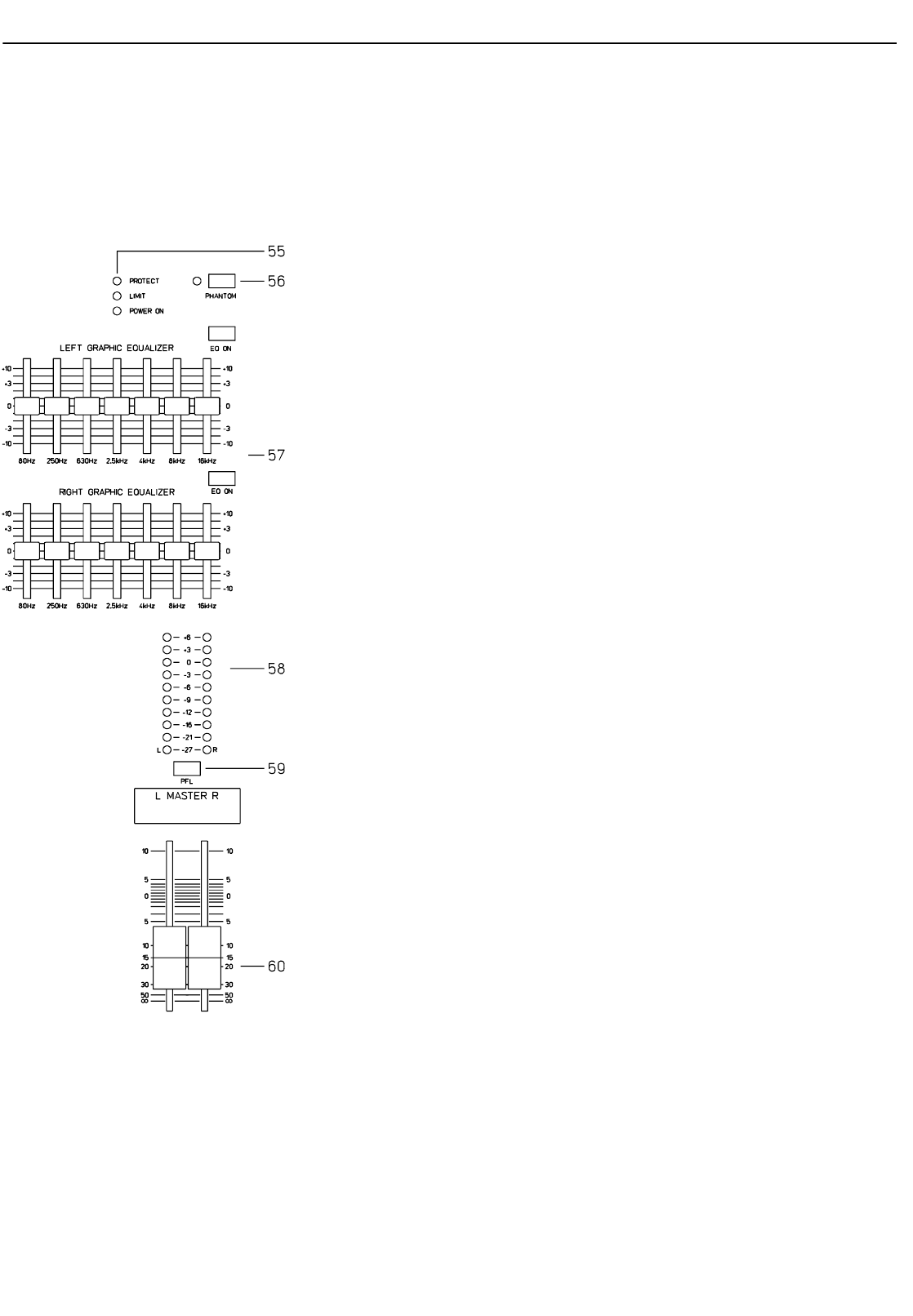
The frequency ranges and the characteristics of the of the equalizer were carefully chosen
for live sound. If you want a clear and intelligible sound, which also provides cymbals and other
instruments with added high frequency detail, you should raise the levels of the 8kHz or 16kHz
bands a bit. If the mids sound too nasal, you should attenuate the 1 kHz and 2.5 kHz frequencies
a few decibels. To provide the kick drum or other bass instruments with more punch, you have
to boost the low frequency range, using the 80Hz or the 250Hz controls. In case the overall
sound is undefined with too much bass, lowering the levels of these two frequency bands will
solve the problem.
When using the equalizer, you should be aware of the fact that in most cases less adjustments
(especially boosting) provides better results. Thus, your first choice should be to establish the
mix using only the input channel EQs tosee if you can get satisfactory results. If so, you can
use the graphic EQ for the AUX3 (monitor), where in most cases it is more needed. You will
find the description of how to include the graphic EQ in the monitor bus later in this owner’s
manual.
58. MASTER LED-DISPLAY
The PSX offers two 10-segment LED ladders to monitor the output levels of the L/R master
signals. The indication range of the LED-meter is 33dB, displaying the levels in dBu which
are present at the EQ OUTPUT and the POWER AMP INPUT. The meter’s 0dB mark is
referenced to a 0dBu output signal at the POWER AMP INPUT. Increasing this level leads
to the power amplifier’s maximum input level of +6dB – equaling an output power of 500 watts
at 4 ohms per channel. Higher levels are not displayed, since the amplifier’s processor limits
the signal at this point. When the LIMIT LED of the status indicator section lights, this shows
that the internal limiter is activated.
59. PFL MASTER
When the master PFLbutton is engaged, the PRE FADER stereo master signal is routed to
the headphones output. The volume of this signal is not affected by the setting of the MASTER
faders.
60. MASTER L + R
Level controls to adjust the output signals of the left and right main outputs (MASTER).
Please make sure that the corresponding input channel fader or the master faders are
set to their minimum position or the STANDBY switch is engaged, before connecting
an external source to an input of the PSX. This will save you, your audience, and
speakers from unnecessary stress.
POWER AMPLIFIER
The PSX’s PROCESSOR-CONTROLLED stereo power amplifier’s design uses bipolar out-
put devices to provide a nominal output power of 500 watts at 4 ohms per channel. The
minimal load impedance of 2.7 ohms allows the operation with a maximum of three paralleled
8 ohm loudspeakers connected to each channel. Their low distortion provides the amplifier
of the PSX with outstanding sound quality that welcomes comparisons with the best profes-
sional high-end, stand-alone audio power amplifiers.
The amplifier is also designed to handle the wear and tear of touring operation. It incorporates
protection against thermal overload, short circuit, HF-interference or the occurrence of DC at
the outputs. Further protection against dangerous back-EMF is provided by a special circuit.
When the PSX is switched on, a relais control switching on of the power outputs. The internal
fans run shortly on full speed, signaling acoustically that the PSX is operational. A limiter
controls the initial current inrush, preventing the mains fuse from being blown during power-
on.
The extensive comparator circuitry constantly monitors the input and output signals and
activates the internal limiters whenever a non-linear operational state is encountered. This
provides reliable protection of the connected loudspeaker systems against overload and
clipping. Even when the maximum input level is overridden, no distortion is heard on the
speaker outputs. The amplifier also incorporates EVI Audio-patented processors to eliminate
transient problems of typical sound reinforcement speaker systems and provides extraordi-
narily precise and powerful reproduction of low frequencies.
MASTER
17 of 32


















